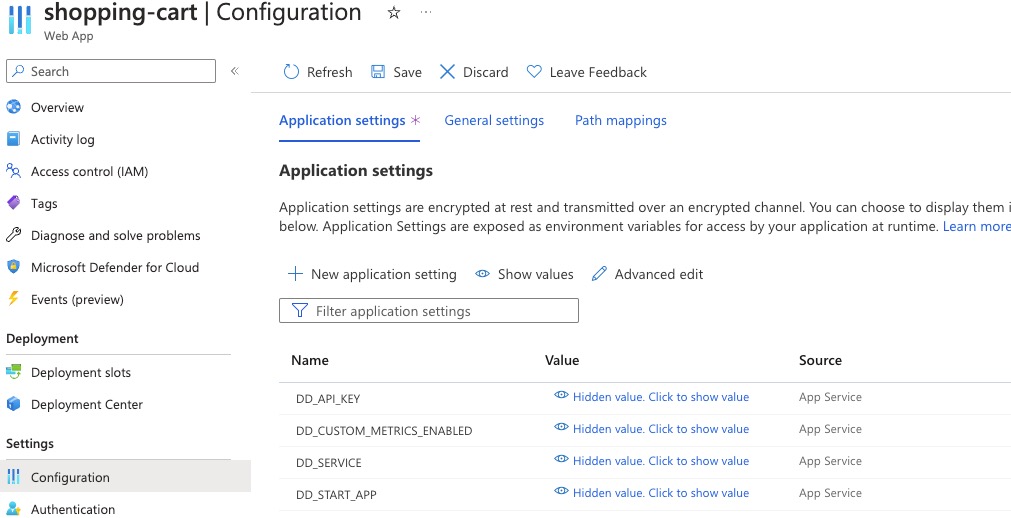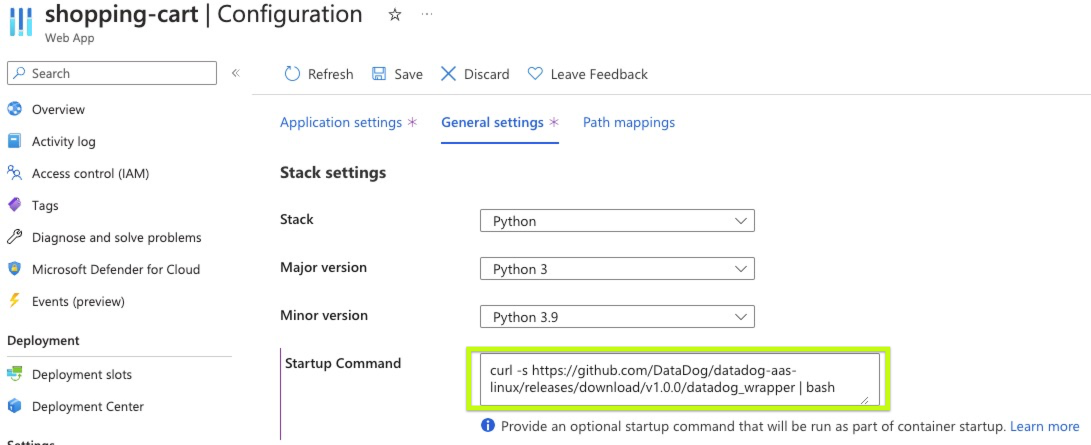- Principales informations
- Getting Started
- Datadog
- Site Datadog
- DevSecOps
- Serverless for AWS Lambda
- Agent
- Intégrations
- Conteneurs
- Dashboards
- Monitors
- Logs
- Tracing
- Profileur
- Tags
- API
- Service Catalog
- Session Replay
- Continuous Testing
- Surveillance Synthetic
- Incident Management
- Database Monitoring
- Cloud Security Management
- Cloud SIEM
- Application Security Management
- Workflow Automation
- CI Visibility
- Test Visibility
- Intelligent Test Runner
- Code Analysis
- Learning Center
- Support
- Glossary
- Standard Attributes
- Guides
- Agent
- Intégrations
- OpenTelemetry
- Développeurs
- Authorization
- DogStatsD
- Checks custom
- Intégrations
- Create an Agent-based Integration
- Create an API Integration
- Create a Log Pipeline
- Integration Assets Reference
- Build a Marketplace Offering
- Create a Tile
- Create an Integration Dashboard
- Create a Recommended Monitor
- Create a Cloud SIEM Detection Rule
- OAuth for Integrations
- Install Agent Integration Developer Tool
- Checks de service
- IDE Plugins
- Communauté
- Guides
- Administrator's Guide
- API
- Application mobile
- CoScreen
- Cloudcraft
- In The App
- Dashboards
- Notebooks
- DDSQL Editor
- Alertes
- Infrastructure
- Métriques
- Watchdog
- Bits AI
- Service Catalog
- API Catalog
- Error Tracking
- Service Management
- Infrastructure
- Universal Service Monitoring
- Conteneurs
- Sans serveur
- Surveillance réseau
- Cloud Cost
- Application Performance
- APM
- Profileur en continu
- Database Monitoring
- Agent Integration Overhead
- Setup Architectures
- Configuration de Postgres
- Configuration de MySQL
- Configuration de SQL Server
- Setting Up Oracle
- Setting Up MongoDB
- Connecting DBM and Traces
- Données collectées
- Exploring Database Hosts
- Explorer les métriques de requête
- Explorer des échantillons de requêtes
- Dépannage
- Guides
- Data Streams Monitoring
- Data Jobs Monitoring
- Digital Experience
- RUM et Session Replay
- Product Analytics
- Surveillance Synthetic
- Continuous Testing
- Software Delivery
- CI Visibility
- CD Visibility
- Test Visibility
- Exécuteur de tests intelligent
- Code Analysis
- Quality Gates
- DORA Metrics
- Securité
- Security Overview
- Cloud SIEM
- Cloud Security Management
- Application Security Management
- AI Observability
- Log Management
- Pipelines d'observabilité
- Log Management
- Administration
Enabling AAP for Azure App Services
Cette page n'est pas encore disponible en français, sa traduction est en cours.
Si vous avez des questions ou des retours sur notre projet de traduction actuel, n'hésitez pas à nous contacter.
Si vous avez des questions ou des retours sur notre projet de traduction actuel, n'hésitez pas à nous contacter.
Compatibility
Only web applications are supported. Azure Functions are not supported.
Note: Threat Protection through Remote Configuration is not supported. Use Workflows to block IPs in your WAF.
| Type | OS | Threat Detection |
|---|---|---|
| Java | Windows, Linux | |
| .NET | Windows, Linux | |
| Node | Linux | |
| Python | Linux | |
| Ruby | Linux | |
| PHP | Linux |
Setup
Set application settings
To enable AAP on your application, begin by adding the following key-value pairs under Application Settings in your Azure configuration settings.
DD_API_KEYis your Datadog API key.DD_CUSTOM_METRICS_ENABLED(optional) enables custom metrics.DD_SITEis the Datadog site parameter. Your site is. This value defaults todatadoghq.com.DD_SERVICEis the service name used for this program. Defaults to the name field value inpackage.json.DD_START_APPis the command used to start your application. For example,node ./bin/www(unnecessary for applications running in Tomcat).DD_APPSEC_ENABLEDvalue should be 1 in order to enable App and API Protection
Identifying your startup command
Linux Azure App Service Web Apps built using the code deployment option on built-in runtimes depend on a startup command that varies by language. The default values are outlined in Azure’s documentation. Examples are included below.
Set these values in the DD_START_APP environment variable. Examples below are for an application named datadog-demo, where relevant.
| Runtime | DD_START_APP Example Value | Description |
|---|---|---|
| Node.js | node ./bin/www | Runs the Node PM2 configuration file, or your script file. |
| .NET Core | dotnet datadog-demo.dll | Runs a .dll file that uses your Web App name by default.Note: The .dll file name in the command should match the file name of your .dll file. In certain cases, this might not match your Web App. |
| PHP | cp /home/site/wwwroot/default /etc/nginx/sites-available/default && service nginx reload | Copies script to correct location and starts application. |
| Python | gunicorn --bind=0.0.0.0 --timeout 600 quickstartproject.wsgi | Custom startup script. This example shows a Gunicorn command for starting a Django app. |
| Java | java -jar /home/site/wwwroot/datadog-demo.jar | The command to start your app. This is not required for applications running in Tomcat. |
Note: The application restarts when new settings are saved.
Set General Settings
Go to General settings and add the following to the Startup Command field:
curl -s https://raw.githubusercontent.com/DataDog/datadog-aas-linux/v1.4.0/datadog_wrapper | bash
Download the datadog_wrapper file from the releases and upload it to your application with the Azure CLI command:
az webapp deploy --resource-group <group-name> --name <app-name> --src-path <path-to-datadog-wrapper> --type=startup
Testing threat detection
To see App and API Protection threat detection in action, send known attack patterns to your application. For example, send a request with the user agent header set to dd-test-scanner-log to trigger a security scanner attack attempt:
curl -A 'dd-test-scanner-log' https://your-function-url/existing-route
A few minutes after you enable your application and exercise it, threat information appears in the Application Signals Explorer.
Further reading
Documentation, liens et articles supplémentaires utiles:


